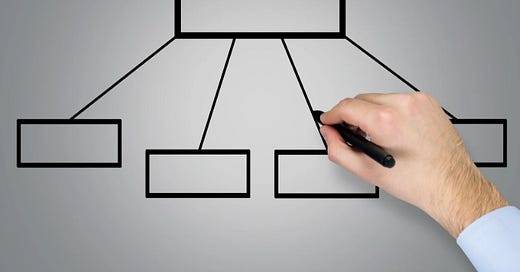AI and Span of Control (Edition 20)
AI is changing everything. Span of Control - often a proxy for managers' stature in an organization - is going to be no stranger.
Span of control has traditionally been a key measure in management. More than simply being an instrument for effective organizational design, individuals have generally used it as a proxy to measure their stature (and authority) in an organization.
What is Span of Control, if you are unaware? Put simply, it is the count of direct subordinates a manager has.
However, the term is often used loosely. In this post, I am definitely using it loosely to include not just direct subordinates, but also all the indirect subordinates, collectively. Or rather, using it as a proxy of a manager’s authority and stature in an organization.
Like everything else, AI is upending organizational design too. Or to be more specific, autonomous AI agents are. Whether it is an AI agent replacing a human role, or the use of an agent leading to fewer humans being required to perform a certain role, we cannot deny that the great AI agent job upheaval is here.
How would managers who are traditionally used to measuring their stature in terms of subordinate count respond to this upheaval? “I have 300 people in my org” is not uncommon to hear in corporate corridors. How are these managers going to feel when 200 of their subordinates are made redundant by AI? Someone with 20 people in their team - 20 people looking up to them, 20 people asking them for advice, 20 people following their beaten path - is likely going to feel a lot ‘smaller’ when it’s only 7 people doing so.
Now, the managers are not at fault, as it’s basic human nature at play. As a founder, I have felt ‘smaller’ when a 10 person team has become a 4 person team in the past. Or perhaps ‘insignificant’ offers a better choice of words.
At Humantic AI, we are getting ready to launch our Account Research agent Miia. And while salespeople see it as an assistant that will help them research faster and (much) better, we sometimes cross paths with another team in certain organizations.
The Market Research team.
And the reaction from managers in these teams, at least from those who haven’t dwelled on the topic enough - often has a tinge of resistance. In their mind, it immediately raises a question about the impact on their span of control, and even more importantly, on their own job!
(This is more true of junior/mid-level managers. Senior leaders and executive leadership do not always view it the same way. More on that below.)
The answer to this question is twofold.
The first part of the answer lies in a concept I have discussed earlier - consumption expansion. Which means that we consume more with time, so more efficient new products do not always lead to a corresponding loss of consumption of old products.
However, there will likely be some impact in the short term. A 10 person Market Research team could possibly become a 5 or 6 person team. But soon enough, the organization would start consuming a lot more research. And even if the agents are doing 90% of the work, the team would be back to 10 people. Or even 12. Or 15.
(This will not apply to all the teams. Some kinds of teams will disappear. Research is unlikely to be one of them.)
However, it is the second part of the answer that is far more important. And mid-level managers need look no further than senior leaders to take a cue. Or sales leaders.
Senior leaders (as well as sales leaders) view their stature and authority a lot less in terms of human span of control. Don’t get me wrong, they do too. But they look at the ‘economic scale’ a lot more.
“I will be running a $100M P&L instead of the current $30M P&L”, or “I am responsible to bring in $50M in revenue” is a lot more likely scenario at the senior level (or for sales leaders) than it is at the mid-level (or outside of sales).
I believe this is a crucial change that mid-level (or even some senior) managers and leaders will need to start making as AI keeps taking centrestage. They will need to start measuring their authority and stature in terms of their economic impact on the organization. It is not a small change, speaking psychologically (for the individual) or practically (for the organization).
The research team in question, for example, might need to start measuring their impact on pipeline or deal win rates. Did the organizational win rate increase on deals where the research provided by them was leveraged, compared to where it wasn’t? How did this increase play out by deal stage? How much of an organization’s growth increase can be attributed to their team?
I don’t think this change is impossible, but it will likely take a deliberate effort. This change will need to be made for people to get a good measure of not just their stature, but also their growth. And for organizations to get a measure of their impact.
AI is set to change everything. And organizational design is going to be no stranger to it.




